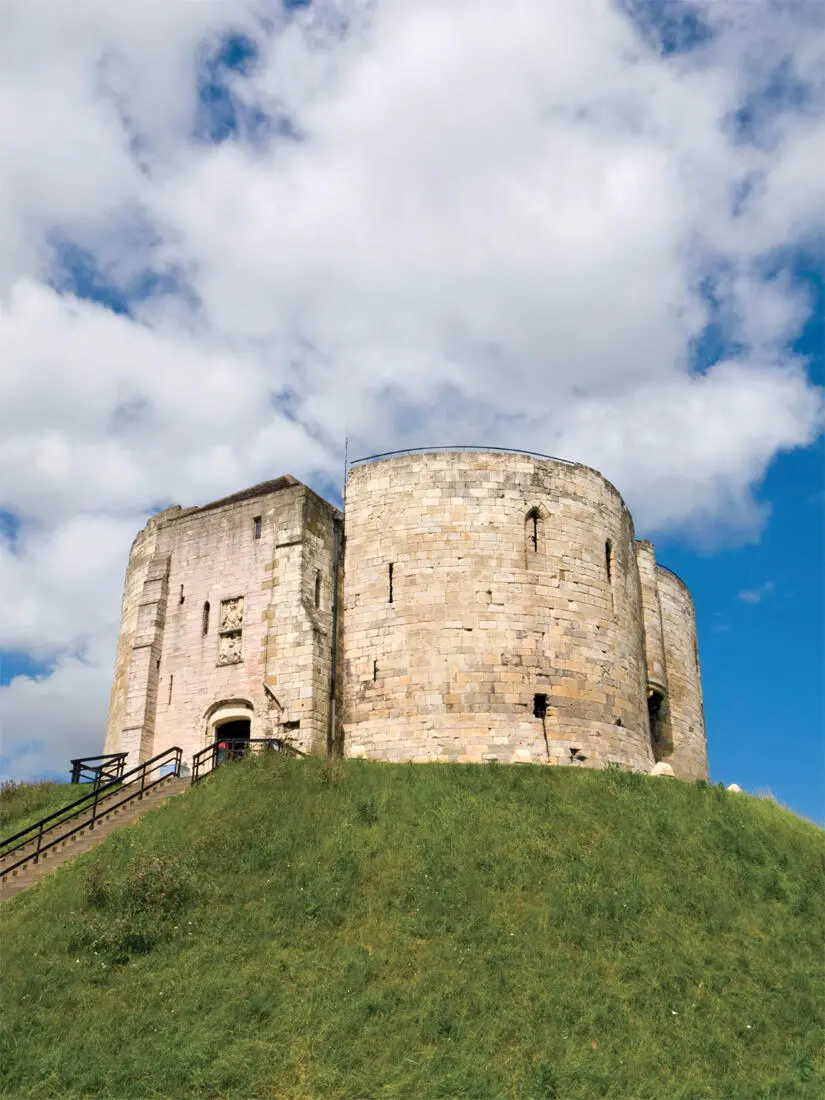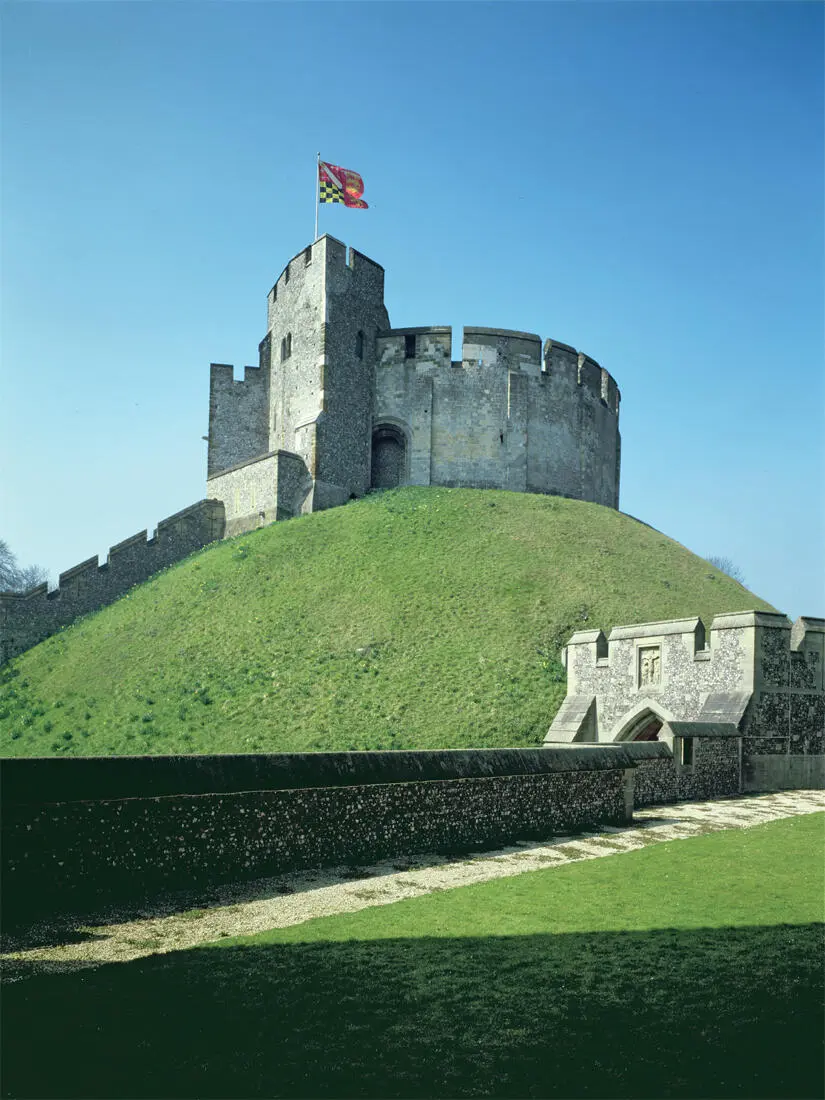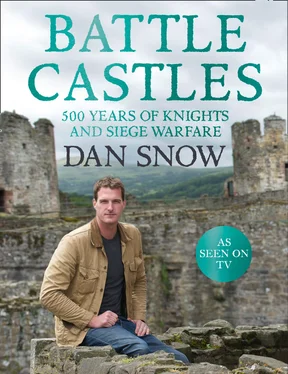William’s attitude to his new subjects only hardened as he grew to know them. Initially he seems to have hoped he could rule through the existing elite. But this uncharacteristic compassion was not rewarded by loyalty. Rebellions broke out with infuriating regularity in the years after the Conquest. From the south-west to the north-eastern tip of his new kingdom he was forced to fight vicious campaigns to secure his new domain. In addition, opportunist neighbours – Irish, Welsh, Scots and Vikings – could be relied upon to raid and harry frontier lands.

Clifford’s Tower, York. The remains we see today are thirteenth century, but the site was once topped by an earlier fortification built by William the Conqueror
© incamerastock / Alamy
Typically, William would crush the rebellion in person and then build castles to ensure a strong Norman presence right across the kingdom. These would be garrisoned by reliable allies, often relatives, who were expected to keep the peace and were allowed to enrich themselves in return. William’s biographer tells how, ‘in castles he placed capable custodians, brought over from France, in whose loyalty no less than ability he trusted, together with large numbers of horse and foot. He distributed fiefs (or landholdings) among them, in return for which they would willingly undertake hardships and dangers.’
First William had to march south-west to Exeter, where he erected a castle in the remains of the Anglo-Saxon burh. The following year he marched north through the east Midlands and East Anglia, planting castles at Warwick, Cambridge and York, among other places. Perhaps the most serious challenge came in 1069 when Edgar, the Anglo-Saxon with the best claim to the throne, invaded northern England, killed William’s lieutenant in the north and captured York, England’s second city. William sent an army north which defeated the rebels, forced Edgar into exile and punished the region heavily, salting the land to make it infertile and slaughtering inhabitants. As land and power was stripped from the English lords and churchmen who William could not trust, a small group of foreigners took over almost the entire national wealth.
Such a heist would have been impossible without castles. William continued building them at strategic points in the kingdom. He created an entire system of land ownership and obligation aimed at supporting the castle, seen as the bedrock of his regime. Land was given to knights, who in return had to serve as garrison for the nearby castle. Even tradesmen like cooks and carpenters were given places to live in return for service. On the south coast, six castles – Hastings, Pevensey, Lewes, Bramber, Arundel and Chichester – were established with a vast hinterland geared up to support them. The Welsh borders were parcelled out, as was the far north of England. Just as the Romans had fortified the coast, so too did the Normans. Whereas the Romans paid for their forts with a sophisticated central treasury and a standing army that served from province to province, Norman castles were designed to be self-sufficient. The local lord and his warriors were rooted to the land, paid not by a distant exchequer, but by the proceeds of what they could grow or acquire locally.
The power of local Norman lords meant William was not alone in building castles. An explosion in castle building followed his accession. Almost one hundred are referred to in sources before 1100, but there were many more. Across England and parts of Wales numerous surviving earthworks date from this time: 85 in Shropshire, another 36 in what used to be Montgomeryshire. John Goodall estimates that as many as 500 could have been founded in the decade after 1066 alone – some built by the king, others by the great magnates who now dominated England, and others still by relatively minor gentry, given parcels of land in reward for loyal service, their names now lost to history. This was a militarized landscape. In the words of the Anglo-Saxon Chronicle , the king and his warlords built castles ‘far and wide throughout the country, and distressed the wretched folk, and always after that it grew worse’. Often mottes were sited in positions of mutual visibility, no more than a day’s march apart, so one garrison could reinforce another that found itself under attack. Visiting these ghostly mounds today, their size much-reduced by 900 years of erosion, one should imagine the three- or four-storey towers which stood on top of them, dwarfing the small dwellings nearby, and think of the wood, earth and stone with which the Normans locked down the country.
The most powerful castle builder in the kingdom, apart from William, was his relative and childhood friend William FitzOsbern, who was given a huge swathe of land from the south coast of England up to the Welsh borders. The various Welsh peoples had maintained an ancient enmity with the Anglo-Saxons which their Norman successors now inherited. Using the river network as modern humans would use roads and rail, FitzOsbern built castles, large and small, across the shifting frontier zone at places like Berkeley, Wigmore, Clifford and Monmouth. He is remembered for the stunning castle at Chepstow, sitting proud on towering cliffs, dominating the sweeping bend of the River Wye. To visit it today is to feel like you are entering a royal palace, and it may in fact have been just that. When FitzOsbern was killed on campaign in Flanders in 1071, the site reverted to King William, and it may have been William who built a palatial fortress on his Welsh border. Tellingly, it is built on the Welsh side, sending the lords of Gwent an unambiguous signal. As in Colchester or London, further clues into the Norman mindset are built into the fabric of the castle. A crumbling Roman fort nearby was looted for bricks, which were incorporated into the walls. William was embracing physically and symbolically the Roman imperial legacy. He was a new Caesar, locking barbaric Britain into a civilized empire. A new imperial project was born, and castles were its symbol.

The shell-keep of Arundel Castle which was built in the twelfth century. The design is of the motte-and-bailey type, but the masonry used is much stronger and more durable than timber
His Grace The Duke of Norfolk, Arundel Castle / The Bridgeman Art Library
What these castles did was make it possible for around 7,000 men to pacify a country of two million people: they were the most efficient ‘force multiplier’ available in this period. This, it has always struck me, was the true reason behind their sudden supremacy. Castles burst onto the scene in medieval Europe not as expressions of strength but of weakness. They were the tool of small-scale imperial powers, such as William’s Normans, who commanded only relatively minor forces. When the Romans invaded Britain 1,000 years earlier, they did so with some 20,000 legionaries and a similar number of auxiliary troops – a massive army which was much larger than the numbers at William’s disposal. While the Romans were able to find and annihilate in battle every British army that gathered against them, William’s forces needed castle walls to shelter them from the English weight of numbers. The sources are full of accounts of Normans hunkering down and simply waiting for rebellions to subside, before sallying out to hunt down the ringleaders and punish the population. The most balanced account of the Conquest is the Ecclesiastical History written by the monk Oderic Vitalis, who had a Norman father and an English mother. His assessment of how the Normans annexed what had been the most powerful state in Western Europe was simple: ‘The king rode to all remote parts of his kingdom and fortified strategic sites against enemy attacks. For the fortifications called castles by the Normans were scarcely known in the English provinces, and so the English – in spite of their courage and love of fighting – could put up only a weak resistance to their enemies.’
Читать дальше














